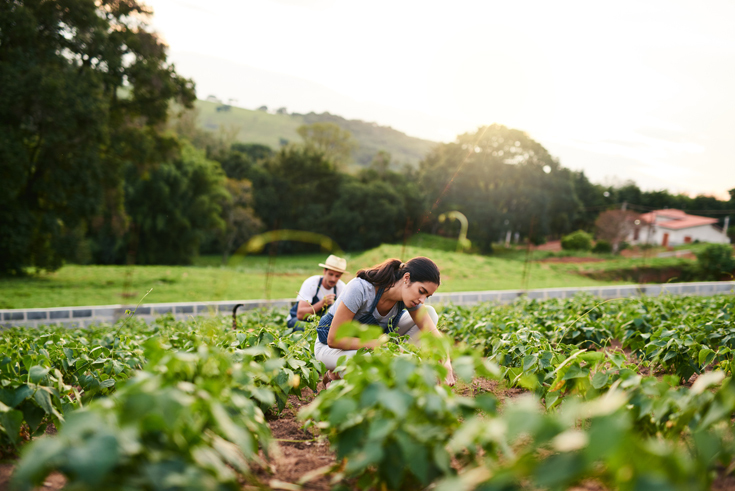Maybe it takes a catastrophic event to change the way that consumers relate to their desires. In Canada, we have no collective memory of food-supply shortages, and most of us have a minimal relationship with the land on which our food is grown. The majority shops in large grocery chain stores, where supplies are brought in from a food depot. We do not know the farmers growing our food, and we do not know their farms. A large portion of what we eat is shipped to us from far away. Because of this, we have lost a sense of seasonal eating, of flavour, and of the labour that goes into producing our food.
Big-store grocery shopping is a hard habit to break. For one thing, it is convenient: you can buy most everything in one spot. And, for another, it’s often the cheapest, since these chains are able to buy in bulk. This type of purchasing has hidden costs, though. Hold up that inexpensive head of lettuce in your mind’s eye and consider the cost of the seed, the price of the hoops under which it is grown, the chemicals used to feed it and kill pests, the electrical expense of heating and cooling its environment, the extractive cost of watering it, the cost of finding, transporting, housing, and paying the seasonal worker who tends and harvests it, and the fuel and other transport expenses of trucking it from the south to a food terminal in Canada. Consider the environmental damage the runoff from these fertilizers and pesticides causes. Consider that the seasonal workers are doing skilled and exhausting labour for little pay, often far from home. Then consider that the grocery chain has also marked up that produce. Of this, Lauren Nurse, of Small Spade Farm, near Stirling, Ontario, says: “We can’t continue to expect to pay $1 for lettuce. Somebody is being exploited under that system, and certainly the environment is being exploited.”
This grocery-chain model has also been demonstrably compromised in the face of COVID-19. Items that we have taken for granted are not always in stock: yeast and toilet paper, but also, anecdotally, fruit and vegetables and specific cuts of meat. We are seeing long lineups and wait times to enter stores. We are experiencing the strange reality of physical distancing as we skirt one another in the aisles. For some of us, this is the first time we have had to think about where the food we buy comes from at all.
The problem is complex. Canada’s food-supply system depends on a cohort of migrant workers to seed, weed, and harvest its labour-intensive produce. Because of the pandemic, the Seasonal Agricultural Workers Program (SAWP), run federally, will be necessarily curtailed. Mandatory fourteen-day quarantines, complex sanitation measures within current housing setups, and travel logistics mean fewer workers are making it here this year, and farmers are spending more to support them. According to the CBC, “Ontario employs up to 20,000 migrant workers a year to perform farm work throughout the growing season. The number nationwide is close to 60,000.” This is a workforce without which, the Ontario Fruit and Vegetable Growers’ Association claims, “domestic food production will be impossible or significantly limited.”
If the pandemic brought us news of the fragility of Canada’s food chain, it was not a revelation to small-scale, sustainable farmers. Organic farms in Canada, which number over 7,200 according to data compiled in 2018 by the Canada Organic Trade Association, are often helmed by individuals working small acreages who strive to protect both local food supplies and the environment.
In the past, their message has largely been ignored. It’s easy to see why when you take into consideration that organic farms represent about 1.5 percent of the total land being farmed in Canada—a number that does not include other sustainable farms that do not have or cannot afford to apply for organic certification. But, now that we are, in fact, experiencing cascading events due to COVID-19, we might just be ready to pay attention.
Small-scale, sustainable farmers are mostly shut out of the large food-supply chain model—major grocery chains don’t bother with their relatively low volumes—and so they have long had to find ways to directly vend their produce to consumers. Bringing food from the countryside where it is grown into the city, in the hopes of selling it to urban consumers, might sound like an obvious fix. And it is true that, in the past twenty years, farmers’ markets have sprung up in many city neighbourhoods. But, as consumers, our perception of markets seems at odds with what farmers tell me of their experience. Farmers’ markets are great for community building, they say, but have unpredictable results for the farmers themselves. When it rains, customers stay home. In the height of growing season, attendance declines as folks are away at cottages and on vacations. Local farmers toil without the benefit of most of the direct farm subsidies that used to be available and, as a group, receive fewer subsidies now than large operations do, meanwhile incurring greater challenges getting their food to market.
Part of the problem, too, is consumer education. For many years, Thomasburg’s Earth Haven Farm, farmed biodynamically by Kathryn Aunger and her son, Aric Aguonie, has been doing community-educational outreach through its Earth Haven Learning Centre initiative. “I grew up a Native not knowing how to be Native,” Aguonie says; he came to farming as a way to reconnect with his roots. He is frustrated by the uphill battle he experiences as he tries to educate people about local food production with regard to planting zones and growing seasons. In the current system of food supply, we are encouraged to make decisions based on criteria made for us by the supply chain—criteria that have to do less with our health and the health of the environment than with the demands of big-box capitalism. In an ideal local food supply, Nurse points out, “Mrs. Peabody doesn’t expect bananas out of season or from an Ontario vendor. We move to a more seasonal model.” Aguonie puts this more baldly: “If you have the word sale above the pile of whatever’s underneath the word sale, they’re gonna get that.”
While farmer’s markets can provide some outreach in terms of education about food supply, many small farmers have developed Community Share Agriculture (CSA) programs as a way to market their products and their messages about sustainable agriculture. CSA is a system in which consumers buy shares in the production of a given farm, the bounty of which is then divided up over the season in food boxes delivered to the shareholders. This means that, in the early season, when crops are just coming up, the consumer might receive a small portion while, later in the season, they get a box that is overflowing with fresh produce. It’s a system that is vital for small operators because it provides cash flow early in the year, which in turn allows for seed and animal purchases ahead of growing season, when income sources for the farmer are otherwise scarce. It also cuts out intermediate retailers like food-box aggregators (small operations that put together food boxes from a variety of local and sometimes imported sources but do not themselves farm), allowing farmers to reap the most from their sales. CSA puts consumers in direct relationship with their food and how it is grown.
Aunger points out that this system, in which consumers see week by week what is being produced and in what quantity, offers its own kind of learning. There might be gorgeous, delicious foraged blackberries. There might also be, say, kale that an insect has fed on. The first astonishment, that the kale is imperfect, gives way to a feeling of marvel: this food is so rich and healthy, of course other creatures want a nibble.
Under COVID-19 restrictions, this system of getting food to table works especially well. “CSA is a great model,” says Emily Vanderwey, manager of the CSA program at Earth Haven, “because we can deliver food while complying with the social distancing recommendations. Food from our farms hasn’t travelled as far, hasn’t been touched by as many hands, hasn’t taken as much energy to be produced and distributed.”
Despite—or perhaps thanks to—their relative size, small farms are often more fleet-footed than larger operations in times of crisis. Within days of the announcement of the Canada–US border closure, Nurse redesigned her crop plan: the large quantities of salad greens that she had planned for the high-end restaurants she previously supplied (and which were not able to open in the pandemic) were swapped out, and a variety of greens and heritage vegetable crops designed to accommodate the different needs of local and urban shoppers got planted instead.
Similarly, in Orono, Ontario, just as Dave Kranenburg and his partner, Emily Tufts, of Kendal Hills Farm, were harvesting mushrooms for contracts with restaurants that would no longer be able to buy them, they immediately reached out to their market network and quickly created an online farmers’ market. Like many brilliant ideas, this one is relatively simple. In its first week, farmers were asked to offer food they had for sale through the online shop, where customers placed their orders. The farmers brought their products to Kendal Hills Farm, where they were sorted, packaged, and delivered to a network of homes not only throughout the GTA but also local. The shop grossed $51,000 in its first week, which suggests a robust demand, with the corollary benefit to farmers of saved transport time and guaranteed sales.
Kranenburg had long been thinking about solutions for the sales and distribution problems his farm and others face, but he says that “this wasn’t a strategic move. It’s not like I was hoping for a pandemic. A lot of us were hoping for a change to the local food system, and something as chaotic as [what] the world is experiencing right now kind of breaks all the habits and norms and allows new ideas that have been percolating to actually maybe take.” Kranenburg hopes projects like this will foretell a paradigm shift in the way Canadians shop for food.
The hard truth is that food produced in a sustainable way is expensive, and we as consumers need to come to terms with this. Small-scale, sustainable farmers do not use chemical sprays to augment nutrients. They build whole integrated systems using organic and biodynamic techniques that are more labour-intensive, that use less fossil fuel–dependent machinery, and that rely on heritage seeds (and collecting them, as well). They also do this on a more human and humane scale.
Compare this to an industrial organic operation where, for example, chickens are selected for their size or egg-laying capacity and bred for these attributes. A free-range designation, which many large operators now have, means only that the chicken has access to the outdoors, not that it actually uses that access point to leave the industrial barn. In a small operation, chicken flocks actually range freely, finding at least some of their own food—which has positive taste and nutrient outcomes. Not housing livestock indoors, not chemically feeding produce, and keeping farm operations human scale all come at a price, but the benefit is borne out in the potential nutrition and flavour of the food and the well-being of the land on which it is produced. Nurse says that the actual cost of producing a dozen organically, sustainably farmed eggs without subsidy is $8. The cost of sustainable food puts it out of reach for many consumers, yes—but, if organic, biodynamic, and other related kinds of production were supported through subsidy and other funding sources for farmers doing this work in sustainable agriculture, it would help level the playing field, lower prices, and make this food more accessible.
York University’s Rod MacRae, whose work focuses on creating a national food-and-agriculture policy for Canada, points out that “the dominant model assumes the supermarkets can keep supply chains operating,” adding that “the big-three chains don’t participate much in the small regenerative farmer model.” In other words, Loblaws, Sobeys, and Metro limit the choices we make insofar as they rarely support local food production. It’s always been lamentable (and strange!) to me that I can pass farm-stand displays of plump, juicy tomatoes in July on my way to the Foodland in Madoc, Ontario, only to find that cheap, hard, flavourless versions, trucked in from the southern US or beyond, are my only option. The fact is that these flavourless versions are developed for their ability to withstand diseases and survive transport, not for their taste. They can be produced more cheaply in part because these operations rely on cheap labour.
The industrial food-supply system we have allowed to develop therefore encourages practices that put sustainable farmers at an impasse. Unsupported by the dominant system and forced to market to a capricious consumer, many small operators have had to maintain off-farm income streams in order to keep farming. For years, Nurse has taken on sessional academic work at OCAD University, where she teaches printmaking. She also has city customers who hire her company to landscape their properties. In effect, she is “paying to farm by using off-farm income in order to steward the land.”
COVID-19 regulations will make farming even more difficult and expensive as all farmers scramble to keep up with new rules in the face of the pandemic. The extensive variety of financial outreach from the federal government for farms affected by the domino effect of border restrictions and other COVID-19-related economic perils does not always extend to small-farm operators.
As a thought experiment, I wonder: if given the choice between two heads of lettuce that appear identical, where one is sustainably and locally grown at $3 and the other has been sprayed with chemicals and imported at $1, which would you choose? The savvy consumer on a limited budget might well choose with his wallet in mind. But what if, in a perfect world, where our government supported the endeavour of sustainability as an imperative, they cost the same amount? And what if that imperative was an initiative that put its might and will behind the health of its citizens, the health of local food-production economies, and the health of the climate and environment? Which head of lettuce would you choose then?
When asked whether he believes that this pandemic will open a way for a lasting, positive reimagining of the way we think about food production and supply, Ralph Martin, author of Food Security, says, “There’s no doubt in my mind that this COVID-19 crisis will help people to understand more about what food is and how it is grown and processed and what foods are healthy. Health is now top of mind, and people have more time than they did before to think about food. It can no longer be taken for granted, and that is positive.”
The small-scale farmers I spoke to are eager for this change. Kranenburg tells me that he believes “small farmers are being called to action,” adding, “We’ve got this—we grow food, we can grow lots of food. It’s just that we need a different way of getting it to people.” Nurse tells me that, within days of putting out a CSA call to her network, she had twenty-five families signed up. Small Spade Farm is only a seven-acre operation, but at its capacity, were Nurse to have support from the community, it could supply a weekly CSA box to 100 families. A shift like that would allow her to quit her off-farm jobs and concentrate on what she loves to do—feed us. Extrapolate from that number, and it is possible that our local, sustainable farming operations—our farmers—could grow much more of our food than they currently do, while contributing to environmental rejuvenation. Not only that but, in this brave new world, Aunger tells me, “the local farmers will prosper and the community will see a drastic change in their health.”
Correction, July 24, 2020: An earlier version of this story had one incorrect spelling of Aric Aguonie’s name. The Walrus regrets the error.




